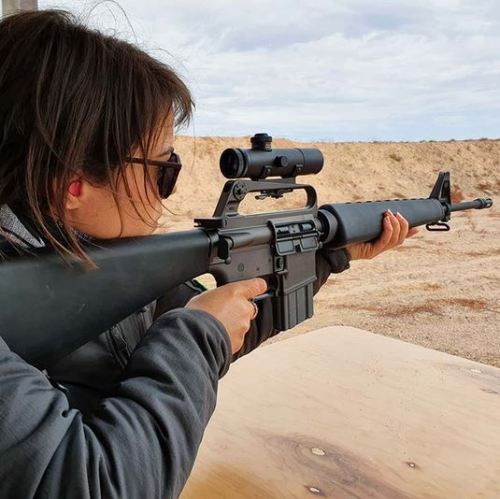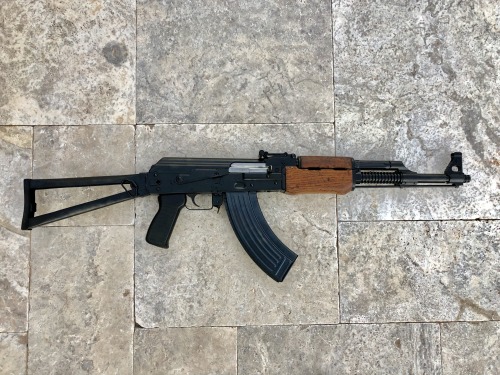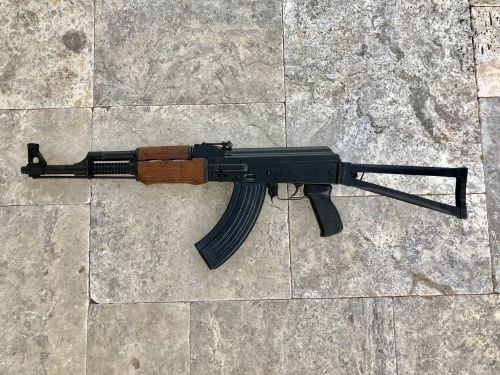#firearms



Flintlock rifle produced by Jacob Dickert of Lancaster County for the Pennsylvania Militia during the War of 1812.
from Rock Island Auctions




Ornate flintlock fowler crafted by Isidro Soler of Madrid, Spain, with lock from Italy, dated 1784.
from Czerny’s International Auction House
The Colt Revolver for Airline Pilots
from forgotten weapons



Flintlock swivel deck gun produced by Lacy & Co. of London, early 19th century
from Rock Island Auctions

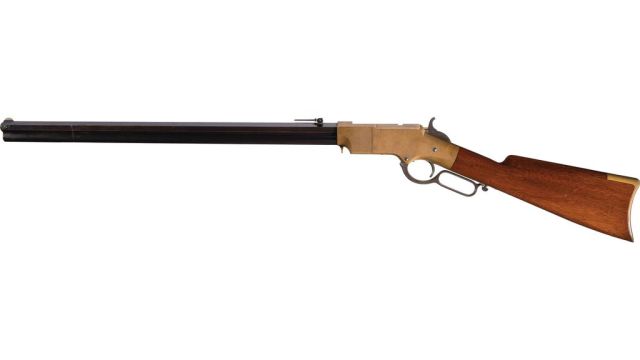

New Haven Arms Henry lever action rifle, United States, manufactured in 1862
from Rock Island Auctions
Some Japanese fellas shooting a traditional Japanese matchlock hand cannon
from
相馬外天会 相馬中村藩古式砲術
相馬外天会 相馬中村藩古式砲術


Factory engraved Colt Bisley with carved ivory grips, shipped on May 18, 1907, and delivered to Krakauer, Zork & Moye Co. of El Paso, Texas.
from Rock Island Auctions
S&W Model M1917
Not too often to you find any revolvers in .45 ACP, a caliber that is mostly associated with the legendary 1911. This M1917 however has been modernized; a new thicker barrel, new grips, new finish and optic rail.
Post link
I’m creating sci-fi guns. Is it possible to simply say this gun is pretty much has no recoil? In fact, what causes recoil? Could some advance tech simply doesn’t have recoil or recoil cushion kind of thing? Also is it ever possible that huge guns have little recoil and tiny guns with huge recoil? Or big guns with little power and tiny ones with huge power?
So, as the second question, it’s Newtonian physics. Specifically, “for every action there’s an equal and opposite reaction.” Recoil experienced by the user is the result of the powder burn in the chamber. Often times, it’s partially mitigated by mechanical considerations in the gun, but at the same time, bolt travel can also contribute to experienced recoil.
Recoil compensation systems exist. These can include gas vents designed to counteract climb, mechanical buffers, and counterweight systems. Part of the problem with recoil management is, simply, the technology we’re using (and have been using for over a thousand years at this point.) When gunpowder burns, it causes gasses to expand rapidly in all directions. This is what propels the bullet down range, but also applies force to the user.
(And, yes, that over a thousand years. The first firearms date back to the 12th or 13th centuries, but the use of gunpowder in China dates back to the first millennia.)
So, even with modern technology, you can significantly reduce experienced recoil. Some of this is physics, but you can redirect that force, though you still have to deal with it.
So, can you do away with recoil entirely? Technically, probably not, but you could potentially reduce it to the point that it is undetectable by the user.
High energy weapons, such as lasers, plasma projectors or particle beams technically would probably have at least some theoretical degree of recoil, even if it was just from the user pulling the trigger. But, we’re not talking about enough to be meaningful. Gauss weapons would probably also have some recoil from accelerating the physical projectile, but in comparison to dealing with burning powder, it’s mild enough that t you could (probably) mitigate perceived recoil entirely.
As for the question of big guns that are weak, why would you do that to yourself? A larger weapon will be more awkward to carry, more difficult to use, harder to manage when not in use. There’s really no point here. You can, technically see this, with antique artillery pieces, which are inferior to their modern counterparts.
That’s the one time when I could legitimately say you might something like a big, heavy, gun that’s underpowered. If it’s technologically inferior to more recent developments.
As for powerful small guns? Yeah, that’s a thing that can happen. Especially when you’re comparing more modern weapons to older ones.
This gets a little awkward because there’s no meaningful way to quantify damage output from firearms. Even a musket can kill you. It’s a question of what the bullet damages. The real advancements have been to things like range, accuracy, capacity, the ability to quickly reload, and long range optics.
A modern subcompact Glock is considerably more lethal than a Napoleonic era musket. But, that’s not because the bullet itself does more damage (in fact it might not.) It’s because the pistol is effective at ranges where the musket’s accuracy is unreliable, and it can easily dump 8 rounds into the user’s target while they’re foe is still reloading for a second shot.
In the end, a bullet is a bullet. If it connects and damages something you need to maintain a pulse, you’ll die. More bullets means that’s more likely for that to happen. While concepts like flatness and stopping power have a reality to them, they’re not good comparative tools to determining whether a gun can kill someone. And, quantified, numerical damage, is a fantasy.
-Starke
Q&A: The Physics of Recoil and Science Fiction Guns was originally published on How to Fight Write.
Is it really possible to jump in front of someone being shot like a shield and take the bullet? This keeps happening in fiction but I always wonder how it’s possible because no one can outrun a bullet. Or is it possible because these characters aren’t attempting to outrun a bullet that’s already fired, but moving in front of the target ahead of the shot, or perhaps idk the jumping in front actually causes the shooter to choose that moment to shoot?
No. There’s a lot of reasons you cannot do this, and they combine together. That said, there is a very specific truth mixed in, which you will see with any competent security detail.
So, the first problem has less to do with the speed of the bullet and more to do with your own brain. This may sound a little strange at first, but you can’t see the world around you right now. Literally, as you’re reading this text, you’re not seeing the world that exists in this moment, you’re seeing snapshot of the world from about 100ms ago. Similarly, you cannot hear the world that exists right now. The things you hear happened roughly 50ms ago. (Don’t take these numbers as absolutely correct because there is some variance between individuals, and I’m also relying on my memory for the sound processing time, so, I could be off by a bit.)
Processing visual data is an extraordinarily complex process. It’s taking data from the rods and cones at the back of your eye and turning that into a picture. It’s also not particularly concerned with being accurate. Everything you see is upside down, your brain flips it. Similarly, you can always see your nose (unless you are extremely walleyed.) Your brain takes that data and intentionally edits around it. All of this comes with a neural cost. It cannot be done instantaneously. So, what you see was the world 1/10th of a second ago. This is not a terrible tradeoff for having vision that can identify objects by outline without needing motion to track your environment. This also means your brain ejects visual data that it doesn’t think is relevant, but that’s a different discussion. (Incidentally, your brain playing fast and loose with data is why you think sight and sound line up. It’s literally your brain screwing with your perception of time. It has a purpose, because it means you can use sight and sound together and can create redundancy in the event that one sense is partially impaired, but your brain is lying to you.)
Technically, there’s a little more time behind what you see and what actually exists. It takes time for light to bounce off of an object and travel to your eye. When we’re talking about close ranges (like within the same room), the speed of light is so high that the travel time is an academic detail at best. This does become relevant when you’re observing objects at great distance. For example, the light you see bounced off the moon hit the lunar surface over a second ago. When you’re looking at Jupiter through a telescope, you’re seeing the planet as it existed 30-50 minutes ago. When you start getting into interstellar distances, then you’re looking at years of travel time. But, as I mentioned, this isn’t relevant when you’re in the same zip code.
If you’re curious, the sunlight you see is about eight minutes old. That’s the travel time from the Sun to the Earth.
Sound travels at 343m/s. Ironically, I can’t quote C from memory, but speed of sound I remember. This is important because many firearms use supersonic ammunition. A 9x19mm cartridge will hit its target before you hear the gunshot. (Assuming both you and the target are at the same distance from the gun. If you’re holding the gun, you’ll hear it first.)
So, let’s crunch a few numbers for a second. That 9x19mm bullet leaves the barrel traveling at roughly 380m/s. If your shooter is 20 meters from their target (so medium pistol range), it will hit the target in ~53ms. It will take ~58ms for the of the sound of the gunshot to reach the victim. It takes ~50ms for the bodyguard to process that they heard the gunshot, meaning that by the time their brain processed that data, it’s been over a tenth of a second since the gun was fired, and 55ms since the bullet struck its target. It could be half a second from the gunshot before they can even react if their reflexes are excellent.
It’s not that you can’t outrun a bullet (you can’t, but that’s beside the point), it’s that by the time you realize the gun has been fired, it’s already hit its target, and your brain is playing catch up.
The situation is a little more complicated with sniper rounds, but it’s a similar story, the bullet has already hit the target before you hear the gunshot (or the crack of the bullet breaking the sound barrier, if it’s far enough away that you can’t hear the original gunshot.)
The truth is, you cannot preventatively react to a gunshot. You can react after it has occurred, but your brain cannot process information fast enough to respond before the event is over.
That should pretty thoroughly shut down the idea of someone leaping into the path of a bullet, but we’re not done.
Usually when you have the cliché of someone diving into the path of a bullet, they’re sacrificing themselves to save the other character. Here’s the problem, that 9x19mm example above? They put a round down range and somehow, someone gets in the way. What happens next is that the bullet passes through the unintended victim, and probably still hits the intended target (with somewhat less kinetic force.) Bullets do not care about your heroic sacrifice and will continue traveling until they get bored and bounce off a bone.
So, I said there was a specific truth in this. It’s not jumping into the path of the bullet. It’s the way a competent security detail will create a wall of meat. Meat that is wearing body armor rated to take incoming handgun fire. But they mean it when they say their job is to take a bullet for their protectee. The critical part of their job is identifying any threat before the gunshot, by then, it’s already too late.
A fairly obvious perk of body armor is that if it will stop a bullet intended for the wearer, it will also protect anyone standing behind them.
Most of the time, a competent security detail will be on alert for any sign of a threat when moving through unsecured areas. Ideally they will want to keep the protectee moving, and not linger anywhere that hasn’t been secured, though circumstances may not allow for that. If given the opportunity, they will place themselves between any potential threat and the protectee. So, for example, they would place themselves between the protectee and a crowd (even a crowd of fans or supporters), if they have the option. (In some cases they will not have that option.) In the event of an incident (whether that’s an attempt on the protectee’s life), their priority will become to extract the protectee to safety. They will close around the protectee, shielding them from potential gunfire with their armor. Exactly what is considered safe may vary, but reasonable bet that they’re moving the protectee to their transportation and getting out of there.
There is a very dark version of this: Crowds will soak gunfire. It’s not 100% reliable, some rounds could get through, but it’s better than being out in the open. If your character has absolutely no qualms about civilian casualties, they can use a crowded area as a shield from gunfire. Those rounds will punch through a couple people, but a densely packed area can be an effective barrier. It’s kind of the opposite of what you’re asking, because your, “victim,” is intentionally putting others in the path of the bullets intended for them, but it is an effective tactic. Moving with the crowd as people scatter and disperse can also be a way to lose pursuers. With a sufficiently ruthless character, it’s even possible that once they’re in the crowd, they may fire a few shots to get people scattering and create chaos. Either to expose and eliminate their pursuers, or to cover their escape.
The cliché about diving into the path of a bullet survives because it’s visually dynamic, and dramatic. (In theory) it’s dramatic for a character to die while saving the life of another, but this incarnation is extremely artificial, and more than a little silly.
So, can you dive into the path of a bullet? Not intentionally, and even if you did, the bullet would probably punch through you and hit the intended target anyway.
-Starke
Q&A: Diving into the Path of a Bullet was originally published on How to Fight Write.
@brownells.europe getting some range time testing out the Retro 4X Carry handle Optic! Thank you all for continually picking these up! Sold us out once again!
Post link
Starting this week off with a simple Quick Tip brought to you by our own Caleb Savant!

CZ 805 Bren S2 - 5.56x45mm

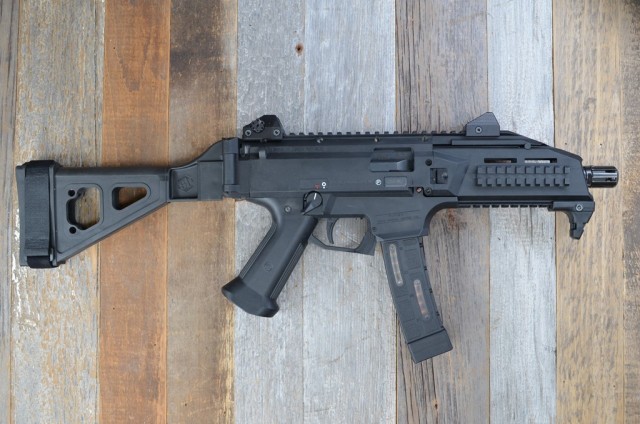

CZ Scorpion EVO 3 - 9x19mm
M72B1 “Khyber Pass”
A custom build AK variant that uses the Yugoslavian M72B1 RPK as the base rifle. The barrel is shortened to 16″ inches long, removing the RPK’s bipod attachment. Most Khyber Pass AKs are generally considered to have the simple side-folding triangle stock. What you’re left with is basically a heavier AK rifle due to the thicker, finned barrel along with the reinforced RPK receiver. (GRH)
Post link
⠀⠀⠀⠀⠀⠀ ⠀⠀⠀⠀⠀⠀⠀⠀⠀⠀
MΔΠUҒΔCTURΣR: Marlin Firearms
MΩDΣL: 308MXLR
CΔLIβΣR: 308 Win
CΔPΔCITΨ: 5 Rounds
βΔRRΣL LΣΠGTH: 24
By @buffalodiller
#leveraction#rifle#instagood#photogun#firearmlove#guns#firearms#gunpics#hunting#firempotography#gunsdaly#selfdefense#gunporn#progun#armaswords#marlin308mxlr#308winchester#wordsguns
Post link




